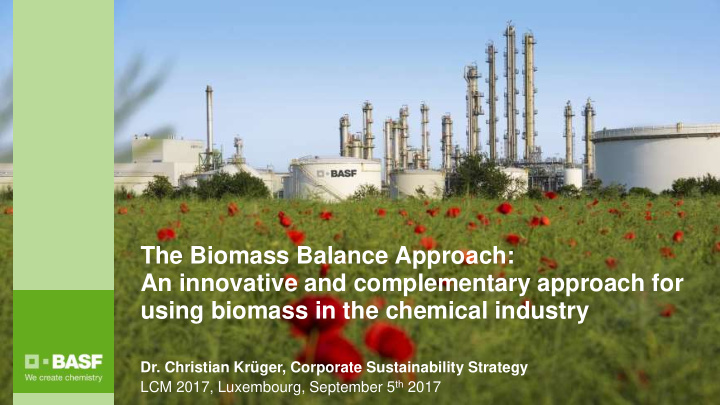



The Biomass Balance Approach: An innovative and complementary approach for using biomass in the chemical industry Dr. Christian Krüger, Corporate Sustainability Strategy LCM 2017, Luxembourg, September 5 th 2017
Four main drivers are influencing BASF’s renewable -based portfolio Competitiveness: Product with a certain Sustainability: Save fossil resources 1 2 performance not accessible or at higher cost or and protect climate market demand Vision 2050: a world in + which nine billion people can live well, and within X the planet’s resources Diversification of raw material base Opportunities: Customer / consumer demand 3 4 and regulations 2
The Biomass Balance Approach Biomass is added at the very beginning of our production chain 3
Biomass Balance is the viable option for an immediate switch to renewable raw materials in the chemical industry Traditional Biomass Balance Dedicated production approach production Biobased analyzed Fossil feedstock Biomass-derived with 3 rd party certification by 14 C method Often different Known performance Same performance product performance > 20.000 products > 20.000 products Not available for all available in available in products production scale production scale Investment in R&D Verbund production Drop-in BASF and new plants Verbund production Often additional cost Often additional cost for renewable for renewable feedstock feedstock 4
How does the Biomass Balance Approach work? Feedstock BASF Production Products Verbund Fossil Conventional Allocated Renewable Use of renewable feed- Utilization of existing Allocation of renewable stock in very first steps of Production Verbund feedstock to selected chemical production (e.g. for all production steps products steam cracker) 5
Challenge: Renewable materials cannot be directed to one specific product Feedstock BASF Production Products Verbund Fossil Conventional Therefore, a credible external certification system is needed Allocated Renewable 6
Our solution: Certification and standardization Feedstock BASF Production Products Verbund Fossil Conventional Allocated Renewable 7
Renewable raw materials need to be sourced sustainably Use certified renewable raw materials Bionaphtha from vegetable and organic waste oils Biogas from organic waste (e.g. kitchen waste) Certification example: ISCC EU Apply standardized sustainability criteria Greenhouse gas emissions savings Responsible biomass production Protection of areas with high biodiversity and large carbon stocks We are exploring and qualifying feedstocks according to international sustainability standards and in dialog with NGOs (e.g. RED*) *RED = Renewable Energy Directive of EU Commission 8
Biomass Balance approaches are addressed in existing standards Sustainability Political and Life Cycle standards for biomass market standards Assessment Enhanced importance of Existing standards and RED* supports existing green public procurement allocation rules already mass balance standards and product labelling accommodate MB RED* describes strict Market labels are already Critical reviews proved requirements for such using biomass balance conformity biomass feedstocks TÜV SÜD CMS 71 is the 1 st standard applicable for chemical industry We are implementing the Biomass Balance approach to existing and upcoming standards *RED = Renewable Energy Directive of EU Commission 9
In LCA calculations the raw material use of fossil comparatives needs to be quantified Model of production processes in BASF’s LCA software according to ISO 14040/14044 Mass flow Naphtha “a” Naphtha fossil based Process A Process C “a” and “b” fossil based PRODUCT Natural gas Process B Process D fossil based Mass flow Natural gas “ b ” Quantification of material use of fossil comparatives by mass flows 10
A LCA calculation shall consider the chemical value of the renewables to allow a fair substitution of fossil comparatives Biomass has often less chemical value than its fossil comparatives Chemical value can be defined as lower heating value (LHV) Biomass balanced LCI can be calculated based on the LCI of the fossil comparative: a (cv BN LCI BN – cv N LCI N ) b (cv BG LCI BG – cv NG LCI NG ) BMB-LCI = LCI fossil + + “a” (amount of naphtha) “b” (amount of natural gas) Biomass balance BMB: Life Cycle Inventory LCI: chemical value factor Cv: N = naphtha, NG = natural gas, BN = bionaphtha, BG = biogas Indices: 11
Summary Biomass balance is the viable option for an immediate switch to renewable raw materials in the chemical industry and is complementary to biobased chemistry allows introduction of certified renewable feedstocks for a broad range of chemical pathways products are drop-in solutions without any compromise in performance can be easily implemented to LCA and shall consider the chemical value 12
BASF purchases a broad range of renewable raw materials Oils & Fats Grains Sugar Wood Lauric oils & (Modified) Sucrose Ligninsulfonate deriv. starches Ethanol Cellulose- Natural oils Dextrose derivatives Organic acids Fatty acids & Glucose syrups Furfural deriv. Tall oil Glycerin derivatives 5.4% of BASF’s total raw material purchase are renewables 14
Recommend
More recommend